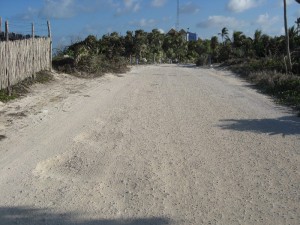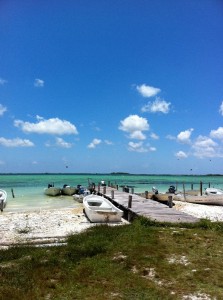Our last day proved to be one of our most memorable, taking us 15 kilometers south of Tulum along the coastline and into one of Mexico’s twelve UNESCO-sanctioned “biosphere reserves” (the most stringent category of land protection in the country, surpassing even their national parks). The Sian Ka’an Biosphere Reserve is an area of over one million acres of freshwater lagoons, mangrove swamps, brackish tidal waters, perfect white-sand beaches with the finest grained sand I’ve ever encountered, and a most amazing phenomenon constructed 80% by natural forces and 20% by Mayans some 1000 years ago: a long, snaking canal cutting right through the extensive mangrove thicket for miles, just deep and wide enough to navigate a boat through or, as we did to for the last segment of our guided tour, float down on your back, letting the current carry you along, tranquilly shaded by the mangroves arching over the canal edges on both sides.
The reserve is almost completely undeveloped (there are still some private properties along its edge, holdovers grandfathered in when the reserve was purchased by the government in the 1980s), and add to this the rich mix of nutrients provided by a calcium-laden bedrock substrate and a constant swirling together of brackish and fresh waters where ocean meets lagoons, and you have the ingredients for a high rate of biodiversity (faunal, if not necessarily floral due to the complete dominance by the ubiquitous mangrove).
Jenna kept a list of all the animals we saw in our ~5 hours in the reserve, ably guided by our tour guide Aldo: several basking alligators, amazing needle fish, and lots of birds (see this earlier post by Jenna).
At dinner later that night, our last meal in Mexico, we looked back on our short but packed five days together and asked what the best and worst experiences were. The biosphere tour, and especially the float down the canal, ranked towards the top for everyone. It was an experience amazing not only for the natural beauty we witnessed, but for how relatively rare it is, especially compared to being at a heavily touristed site such as the ruins of Tulum or, god forbid, Cancun. A tiny fraction of all the tourists to the Yucatan make it down to Sian Ka’an, which adds to the feeling of uniqueness that goes through you after getting a tour of it.

The road doesn't look like much of a hassle, but this is not gravel, it's just limestone substrate, and it's really rough.
Which leads to the question posed in the title to this post. The road from Tulum down to the Sian Ka’an visitor’s center is, shall we say, rough. It’s not paved, and it’s filled with ruts and holes. It’s bumpy and dusty and it took us around 45 minutes to travel less than 10 miles – not fun by anyone’s definition. And this led to an interesting discussion on the way down: what would happen if the state were to decide to pave this road? The answer is undebatable and was confirmed by our guide Aldo: it would instantaneously open the reserve to streams of tourist suddenly unencumbered by the headache of a 45-minute bumpy ride. The trickle of tourists who make their way down there – by my estimates, not more than 20 per day judging by the number of tour companies (3) and the number of tourists they give tours to (6 or less per company per day, limited simply by space in the tour boat) – would turn into hundreds, perhaps thousands. The pristine beach, with its nesting terns, would be invaded (even with the tiny amount of people who currently come into or inhabit the reserve, we found enough trash on the beach to fill three plastic bags). The ecological impact would be undeniable. And who knows what else might follow…. A loosening of development restrictions? A hotel resort? Jet skis in the canal? Commercial fishing of the lagoons?
So for now the road stays rutted and imposing, and to what end? Only a small fraction of tourists can come down it, all of them privileged enough to have access to a car that can make the trip, ecologically interested enough to already want to go, and wealthy enough to afford the guided tour (which costs more than a hotel room, though it does include complementary snacks and beer). And, it’s worth mentioning, for those who do make that trek, the ride is really unpleasant! But this is the price we have to pay for having and preserving these ecologically near-pristine sites, and I’m not saying we should not pay it. Certainly I’m willing to bear 45 minutes of rattled teeth for the experience itself. Am I willing to bear the idea that the reserve is effectively closed off to anyone without means? Well I don’t think the conversation has to end with an open-ended question – it’s not necessarily a zero-sum game, as a slight rewriting of the rules could allow access to people of all income levels without altering the ecological integrity of the site (for example, a series of free visits to local community members doled out with some kind of quota system). But until that happens, I don’t think we should merely celebrate the beauty and uniqueness of this site without acknowledging the social inequalities that it rests upon.







provocative question, and one that seems to sum up your whole trip in many ways. Tourism is almost by definition reserved for those with time and money. But it can protect some things that are worth protecting. Easy for me to say, though, since I’m one of the privileged.
I like your suggestion that there may be ways to reduce the social inequities, if people think creatively.
How interesting the question of paving roads – one which our group in Ghana asked each other time and time again (we had many such bumpy, unpaved, and dusty roads). Only in our case, the question was not to preserve or not a pristine natural site, but how that road might help to develop a memorial/memory site of the slave trade from what it currently is: an empty wound of that history. The road to the town of Salaga, once a bustling slave market, ended in a rather bizarre ‘anti-tourist’ moment – nothing more than a sign pointing out the slave market, and another, outside of town, pointing to an undisclosed location of “slave wells and baths.” Same question for both groups; but very different ponderings and discoveries.